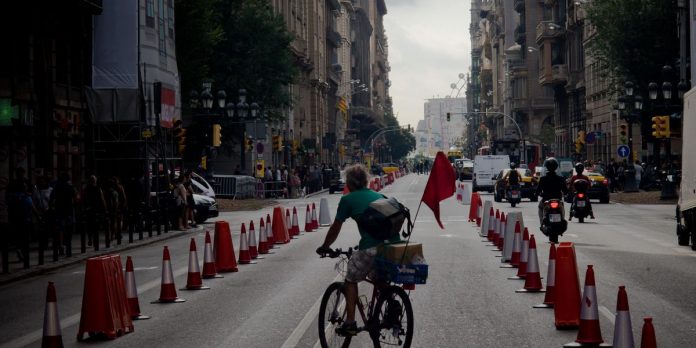There’s no pristine white sand and palm trees framing turquoise water on Ton Salvadó’s “super-islands.” When the Barcelona architect uses the term, what he’s referring to instead are chunks of city, in nine-block groupings, whose interior streets are closed to cars, forming pedestrian “islands” where foot traffic is king.
The idea for super-islands first arose when Salvadó became director of Barcelona’s Urban Model, at a time when the city was embroiled by civic protests over the high price of housing. After some initial success, Salvadó, a Barcelona-native, might have the chance to revolutionize his city’s pedestrian geography with 500 additional super-islands in the future.
He recently spoke at the Coruchéus Library in Lisbon to explain the theory behind super-islands, and how they might be implemented in other cities.
Where did the idea for super islands come from?
The idea of city fragments with restricted access for automobiles is not new. In the 20th century, there were many theorists and urban planners who addressed this issue. In Barcelona, since the 1990s, theories about super-islands have been developed with a very rigid model, initially imagining them as closed-spaces. But we wanted something more adaptable and easier, and so the idea evolved.
We tried to turn around and focus the super-blocks on the issue of pacified space. We went from the idea of super-islands as physical objects to a transformation technique. This technique involves differentiating the streets where passing traffic is replaced by source and destination traffic.
Can you describe a super island for someone who has never seen one?
Think of a continuous street along which you could drive from one part of the city (X) to another (Y). On this street, only vehicles with either part of the city (X or Y) as their origin or destination can circulate. That’s the basic concept of super-islands: only the cars of those who live there can enter. From there, I can expand public space, I can allow children to play in the street.
For example, take a street with two parking lanes and two lanes for cars. In a super-block in Barcelona, we would reduce all this to a single traffic lane, where the bicycles and cars of those who live there would pass. In this way, pedestrian space is increased, which means more green space, less pollution, less noise, and fewer accidents.
The important thing is to do a good job identifying which streets are where plazas can be created, thus multiplying the number of plazas throughout the city.
What Barcelona looks like as a “super island”
Ajuntament de Barcelona
So residents are still allowed to circulate freely with their cars?
Yes, that’s the idea. Circulation is not eliminated. We do not eliminate this right for people who live in the area.
Despite all the benefits, there’s been some resistance to super-islands. Why?
I use an analogy: you notice right away when you have a problem with your stomach, or your vision. But then there are also diseases that seriously impact your physical well-being, but that you probably don’t notice right away, like diabetes. This is what is happening to us with the planet.
This is an emergency, not a minor issue: either we act very quickly, or we will have a serious health problem.
One of the problems is the local increase in temperature in urban areas. In cities like Lisbon and Barcelona, where there is a lot of pavement and dense housing, this issue needs to be thought about. It requires education, and this can only be done well with the help of local government.
The problem is people who don’t accept the science and the data, and who put their personal interests above collective ones. You need to talk to them. I have to talk to my neighbors about how many cars negatively affect our health. And the truth is, we have to make cities spaces for walking and cycling. Because if that infrastructure is not developed, then in cities where there are cars, bicycles and scooters, most people will choose the car for their daily commute.
Why do people continue to prefer cars?
The car lobby is many years old. Car ads do things like show vehicles passing through fantastic landscapes and telling us that that is freedom. You don’t realize that the car is a huge expense on a family’s budget. But to eliminate vehicles, you have to offer something in return.
In a city with sidewalks like Lisbon, sometimes you can’t walk because they’re too narrow–so you need wider sidewalks for that.
The public transport system needs to be strengthened. The order must be reversed: at the moment, cars are in the first place, pedestrians last. We have to put pedestrians first, then bicycles and scooters, then public transport, and only then, individual auto transport.
This is not an issue just for Lisbon, or Barcelona, or Paris: it is a global issue. If we don’t understand, we are lost. There is no evidence greater for this than this couple years!
What worries me the most is that we didn’t learn from the pandemic: that was when we could have realized that the less we move, the more fauna, the more vegetation, the better air quality we have. We can’t go back to the way things were. We are at a dead end, there is no alternative.
From Your Site Articles
Related Articles Around the Web

